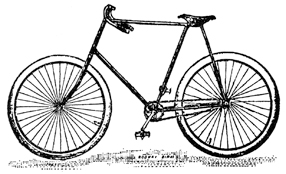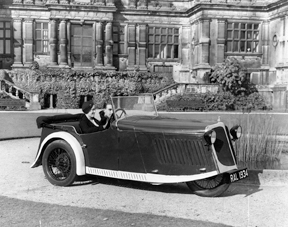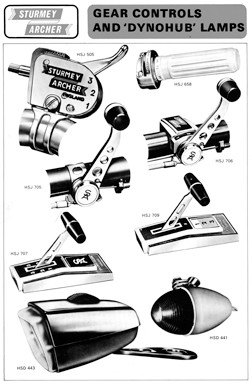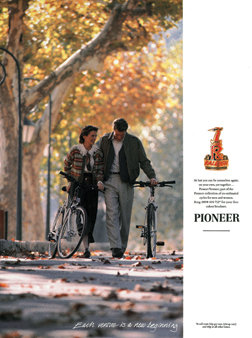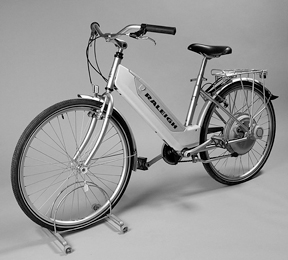About the book
Founded in Nottingham, England,
in 1887, the Raleigh name still
appears on bicycles sold today
around the world. In fact, there are
now two distinct Raleigh companies,
one in England, the other in the
United States, each with its own
product range tailored to their
respective markets.
Author Tony Hadland, with the
help of several contributors, has
meticulously researched the
development of the Raleigh brand
through the 125 years of its
existence.
Table of Contents
Introduction and Acknowledgments
Chapter 1. Beginnings, 18481888
Chapter 2. Early Expansion,
18881895
Chapter 3. North America,
18911898
Chapter 4. The Fairbanks Fiasco,
18931899
Chapter 5. The 1896 Company,
18951899
Chapter 6. The 1899 Company,
18991908
Chapter 7. Edwardian Bicycles,
19011910
Chapter 8. Coming of Age,
19081914
Chapter 9. World War Iand
Another Company, 19141918
Chapter 10. Post-war Challenges,
19181921
Chapter 11. Management and
Workforce, 19201945
Chapter 12. Buildings and Plant,
19201945
Chapter 13. Distribution and
Sales, 19201945
Chapter 14. Bicycles, 19191945
Chapter 15. Raleigh in Ireland,
19331945
Chapter 16. Munitions Work,
19361945
Chapter 17. Management and
Workforce, 19451959
Chapter 18. Buildings and Plant,
19451959
Chapter 19. Acquisitions and
Mergers, 19451960
Chapter 20. Overseas Sales and
Production, 19331959
Chapter 21. Marketing, 19451959
Chapter 22. Bicycles, 19451959
Chapter 23. Lightweight Cycles,
19451959
Chapter 24. The Reg Harris Years,
19481957
Chapter 25. Post-Boom Slump,
19561959
Chapter 26. Saturday Night and
Sunday Morning, 1960
Chapter 27. Merger, Management,
and Workforce, 19601987
Chapter 28. Production
Facilities, 19601987
Chapter 29. Quality, Design,
Testing, and R&D, 19601987
Chapter 30. Marketing, Sales, and
Financial Performance, 19601987
Chapter 31. Raleigh Overseas,
19601987
Chapter 32. Mainstream Cycles and
Toys, 19601987
Chapter 33. Small Wheels,
19591987
Chapter 34. High-Rise Bikes,
19631982
Chapter 35. BMX and MTB,
19611987
Chapter 36. Lightweights and
Racers, 19601987
Chapter 37. Racing Results,
19601987
Chapter 38. Specialist Bicycle
Development Unit, Ilkeston
Chapter 39. Management and
Finance, 19872010
Chapter 40. Production
Facilities, 19872002
Chapter 41. Marketing, 19872010
Chapter 42. Bicycles, 19872010
Chapter 43. Raleigh in America,
19602011
Chapter 44. Raleigh Motorized
Chapter 45. Sturmey-Archers
Bicycle Products
Chapter 46. The Art and Image of
Raleigh, 18862011
Appendices
I. Raleigh Frame Numbers
II. The Heron Head Badge
III. Sir Walter Raleigh
IV. Raleigh Racing Successes
V. Spelling, Units, and Money
VI. Illustration Sources
Sources and Select Bibliography
Index of Names
What the Critics Say
This is an enormous work,
encompassing 368 pages, covering the
entire history of the iconic British
bicycle brand in no fewer than 46
chapters, from the birth of (company
founder) Frank Bowden in 1848 to
2011.
In many ways, this is the story of
our island race writ (very)
large--its growth to imperial glory
and sad retreat as bigger and
clumsier players strode onto the
world stage. At some time or another
in the century of manufacturing from
1880 to 1980, Raleigh had a toe-hold
just about everywhere.
Like the big British car and
motorcycle manufacturers, Raleigh
seems to have developed a rather
complacent attitude after so many
decades at the top of its game, and
when younger, sharper operators
arrived, it just crumbled. According
to Marvin Cresswell, who worked for
Raleigh's marketing department for
thirty years, the declining years
proved to be a frustrating period:
'The marketers, who had done so much
to establish the brand image of
Raleigh, were succeeded in the 1960s
and 1970s by complacency, lack of
imagination and in many cases,
ineptitude.'
The 46 chapters in this huge work
are mostly laid out chronologically,
thank goodness, but there are a few
fascinating asides, such as
motorised bicycles, and the last
chapter, The Art and Image of
Raleigh. This covers the history of
Raleigh advertising, which reads as
something of a metaphor for the rise
and fall for Raleigh itself.
Raleigh is a fascinating work
by a master on the subject.
A to B Magazine, England,
No. 87, December 2011
|



